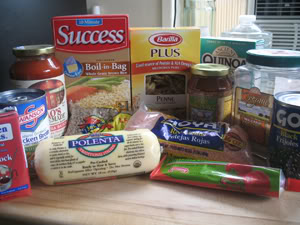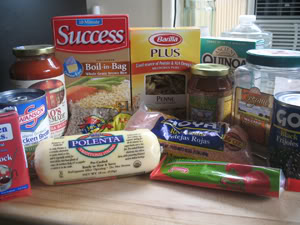
Yesterday was a momentous day for me: At 9:30 in the morning, my doorbell started ringing. In walked a parade (a short parade, but a parade nonetheless) of moms and children. Four moms, two infants, and a toddler, to be precise. These were my new pupils, the first students in my Parents Need to Eat, Too cooking class. Well, the moms were, anyway—the kids were a fun bonus.
Once we’d settled down around my kitchen table, with coffee poured and children occupied (the toddler was thrilled to discover Harry’s train table, which she had all to herself since junior was in preschool), I asked each mom why she’d signed up for the class. Their answers were strikingly similar, even though their situations were quite different. The mom of three under four, whose infant dozed contentedly in his sling, wanted help with variety so she wasn’t always serving the same things, and time management—no surprise there. (Though she did share one trick I find ingenious: Each day of the week is assigned a different kind of food—Monday is Pasta Night, Tuesday is Fish Night, etc. The recipes change, but the meal’s foundation is the same. Very helpful for planning!) The new mom, whose six-month-old made my ovaries ache with her big blue eyes and quick grin, loved to cook but hadn’t yet figured out ways to actually do it with an infant constantly attached to her body. She was also used to cooking ambitious, complicated recipes, and needed something simpler to rely upon. One toddler mom, whose son (one of Harry’s bestsest buds) was in daycare that morning, wanted simple, healthy stuff that a novice cook like her could handle—and if her son would eat it, too, so much the better. And the other toddler mom, whose daughter was so happily playing with Thomas and his friends, wanted just about everything the other three wanted. I smiled, because I knew exactly what each woman was talking about—at one point or another during the last two-and-a-half years, I’ve felt that way myself. The difference is, I’ve figured out some ways to get dinner on the table and still have time for Harry, Stephen, and sometimes even me.
The place to start is the pantry. When you’re dealing with a newborn—or three under four, for that matter—supermarket shopping is one of those priorities that often gets pushed aside. So having cupboards stocked with things that can make quick, nutritious meals is key. Equally key is knowing which processed foods—yes, you read that right, I said processed foods—are helpful and even necessary at this stage of the game. My rule for moms who are living on takeout and wishing they could cook instead: Aim for good enough. Anything homemade is better than yet another order of Kung Pao Chicken. If it’s jarred spaghetti sauce, which I believe is a must for the New Mom’s Pantry, look for one with as few ingredients as possible, and only ingredients you’d use if you were making it yourself. High fructose corn syrup is not an ingredient in Little Gram’s Sauce.
That said, here’s my list of must-haves for the New Mom’s Pantry:
PASTA, RICE, GRAINS
• Barilla Plus pasta, whatever varieties you like (the yellow box): it’s full of protein, fiber, and Omega-3s, making it exceptionally healthy pasta. And it doesn’t have the musty flavor & mushy texture of whole wheat pasta.
• Orzo or other small-shaped pasta: Barilla Plus doesn’t make any small pasta, but it’s a good idea to keep some on hand to add to soups or quick pasta salads.
• No-boil lasagna noodles. Did you catch the “no-boil” part? Nuf said.
• Success Brown Rice: Normally I’d say to hold out for the real thing in order to get the full nutritional benefit, but new parents don’t have that luxury. Success Brown is still healthier than white, but it’s much easier to cook and it holds well.
• Long-grain brown rice: For times when you do have the wherewithal. And it’s vital for Lentil & Brown Rice Soup.
• Aborio rice: In a future post you’ll be learning to make a super-easy risotto in the slow cooker, so you’ll want to keep some on hand.
• Shelf-stable polenta logs: If you can find shelf-stable polenta rather than the refrigerated kind, go for it. It’ll last longer, and who knows when you’ll have time to cook it.
• Quinoa: Not technically a grain (though it behaves like one), quinoa is full of protein, fiber, magnesium, and iron, and gluten-free, it’s a fabulous thing to keep on hand. Cooks quickly, too!
• Steel-cut oats: Oatmeal has long been believed to be a galactagogue—something that increases breastmilk supply—and making steel-cut oats overnight in the slow cooker is about the easiest thing in the world. (Another post I’ll be working on soon.)
• Cornmeal: Oh, how I love thee, cornmeal. Cornbread is a quick and easy way accompaniment for chili, soups, etc, and can easily be thrown together during baby’s nap.
• Couscous, whole wheat if you can find it: Boil a little salted water, dump it in, and it’s ready in five minutes. Quicker than take-out.
CANNED & JARRED GOODS
• Beans, beans, beans: Black, white (cannellini), chick peas, red kidney…
• Broth: Chicken, beef, vegetable. My cabinet always has cans, small juice-box sized, and quart cartons. Look for low-sodium varieties.
• Tomatoes: chopped or diced (without added seasonings like basil or garlic), sauce, puree. Don’t bother with whole unless you like squishing them in your hands—chopping is just another step you don’t need!
• Tomato paste in a tube is a must-have—very few recipes call for an entire can of paste, so with a tube you squeeze out what you need & refrigerate the rest.
• Anchovy paste in a tube is a must-have for similar reasons, even if you think you don’t like anchovies (I don’t!). The paste dissolves into the dish & leaves a depth of flavor that’s subtle but important.
• Chipotles in adobo: Buy a small can, use them sparingly with seeds scraped out & discarded (and don’t forget to use the sauce!), and refrigerate the rest indefinitely. Adds warmth and a bit of heat to tomato-based dishes, beans, etc.
• Tuna: I always buy light tuna in olive oil, imported from Italy—it’s in most supermarkets. Light tuna has fewer mercury worries, and the Italian stuff is very good quality.
• Jarred pasta sauce: Hey, I’m a realist. Sometimes the best you can do—really—is spaghetti with jarred sauce. All I ask is that you make sure you buy the good stuff—I recommend Rao’s especially. It costs more, but a look at the ingredients list will show you why: It’s made from real stuff. Tomatoes, garlic, olive oil, salt, maybe basil. It’ll set you back $8 a jar, but it’s still cheaper—and healthier—than takeout. Plus it’s useful for a quick lasagna or baked ziti.
• Artichoke hearts: Use marinated ones to liven up salads (I use the marinade to make a quick salad dressing), and plain ones in recipes.
• Low-sodium soy sauce: A dash of this adds flavor (and salt, of course) to everything from salad dressings to marinades. Not just for stir-fry.
• Worcestershire sauce: Its uses are practically limitless.
• Rice (also labeled rice wine) vinegar: Adds a light Asian flavor to salads, sauces, marinades.
• Sesame oil: Same as the rice vinegar.
• Barbecue sauce: Just like with pasta sauce, look for as few ingredients as possible, and ones that you recognize. Try to avoid high-fructose corn syrup. One brand we really like is Dinosaur.
• Trader Joe’s simmer sauces: Tasty, not too processed, and super-easy. Cut up a chicken breast or two, toss in whatever veg you have, and serve it over Success Brown Rice.
• Vermouth: I use this as a substitute for white wine in risotto and just about any other recipe that calls for it. It’s shelf-stable when opened, so I never have to worry about wasting a good bottle of wine. Of course if you drink white wine regularly, skip this one.
• Mustard: for sandwiches, salad dressings, recipes.
• Peanut butter: Look for “natural” peanut butter—the only ingredients should be peanuts and salt. It’s the kind with the oil floating on top; it’s a pain to stir it back in the first time, but if you keep it in the fridge after that it won’t re-separate.
DRY GOODS
• Split peas, red lentils, green (brown) lentils, and black lentils (from Trader Joe’s): None need pre-soaking and all cook quickly, so they’re perfect for healthy, no-planning-needed meals.
• Nuts: pine nuts, pecans, almonds (whole, slivered, sliced, Marcona)—whatever kinds of nuts you like, keep some on hand. Toss into salads, pasta dishes, oatmeal.
• Flour
• Breadcrumbs: Sauté a half-cup in olive oil for a quick, crunchy topping to liven up spaghetti & jarred sauce. Even better when you add some grated parmesan cheese.
• Sun-dried tomatoes: I prefer the kind that’s NOT packed in oil, for calorie-watching reasons. But if you’re not concerned with that, the oil-packed ones are deeelicious.
• Dried fruit: Whatever kinds you like. I always have raisins, cherries, blueberries, cranberries, papaya (Harry’s favorite), and figs. Trader Joe’s has a great selection.
PRODUCE
OK, so technically these aren’t “pantry” items, but if you keep these around you’ll almost always have what you need to make a good, healthy, quick dinner. (You’ll note I left out broccoli—I found it too much effort to clean & cut when Harry was very small. Once you’ve got your kitchen legs a bit, it’s a great thing to have around.)
• Potatoes: I keep Yukon Gold and Sweet Potatoes on hand. YGs are versatile—mashed, roasted, in stews—and SPs are super-healthy. Plain ol’ Russets are also good: a stuffed baked potato can be a perfect easy dinner.
• Garlic
• Onions
• Zucchini
• Eggplant
• Red Peppers
• Baby Spinach
• Grape Tomatoes
• Carrots
• Celery
FREEZER
I buy all my frozen fruits & vegs in bags, never boxes—that way I can use as much or as little as I need, without having to defrost a block.
• Chopped spinach
• Mixed vegetables (corn, green beans, peas, and carrots)
• Peas
• Corn
• Mixed berries and/or strawberries & blueberries
• Sliced peaches
• Mango
• Pillsbury pie crust (from the refrigerator section, I just pop it in the freezer)
• Whole wheat pizza dough (I use Trader Joe’s, again from the fridge section)
• Ground turkey breast
• Ground beef (I buy extra-lean—it’s got less fat & cholesterol than regular ground turkey)
• Trader Joe’s buffalo burgers (buffalo is even better for you than extra-lean ground beef!)
• Veggie burgers (I like Morningstar Farms Garden Veggie Patties)
• Ice cream (we’re not going to cook with this, but every new parent needs ice cream)
For the actual cooking portion of our first class, we made Spaghetti alla Puttanesca. Each of us prepped our own ingredients, and my students packed theirs up to take home and cook later. Then we all gathered around my stove while I cooked what would be my family’s dinner later that night—the olive oil hit the pan, and ten minutes later the sauce was ready. I gave the ladies instructions to start cooking when the pasta goes into the pot, and sent them on their way.
The most rewarding part for me: Hearing back from my moms, who raved about how wonderful—and easy—their dinner was.
What are yourmust-haves for the pantry? Anything I’ve missed? I’d love to hear about it!
